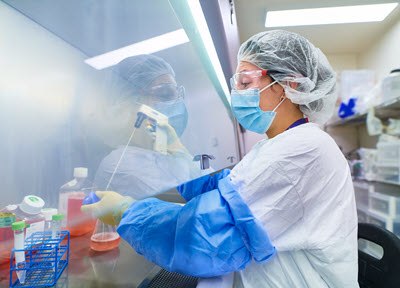Cell and Gene Therapy Manufacturing: Upstream Processing for AAV and Lentivirus Platforms

Operator working in biosafety cabinet
THE CELL AND GENE THERAPY REVOLUTION IS HERE
The promise of cell and gene therapies has been long in coming. These powerful technologies are a potential lifeline for patients with diseases for which there are no existing treatments offering the possibility of either a treatment or a cure. But making these new therapies at the scale and accessible price to meet the demands remains a challenge.
This technical article will provide a high-level overview of cell and gene therapy production, with a focus on the upstream cell culture production of viral vectors.
- Viral vector technologies approved by regulators
- Processing Needs for Viral Vector Manufacturing
- Improved upstream productivity for viral vectors
Viral Vector Technologies Regulatory Approvals
The early days of developing viral vector therapies were rocky: patient safety concerns and a patient death halted progress for many years1. The industry learned from these early setbacks and focused efforts on research and development to improve our understanding of the technologies. Since then, major advancements have been made and, if investments are any indication of potential, viral vector therapies will transform medicine.
Investments have paid off with many clinical trials and to date (2024) the US FDA lists 36 approved cell and gene therapy products2. Some notable achievements include Biomarin’s Roctavian™, the first gene therapy for adults with severe hemophilia A; bluebird bio’s Zynteglo®, the first U.S. approval for a lentiviral vector gene therapy and Vyjuvek™, an approved Herpes Simplex Viral (HSV) therapy for treating wounds in patients with skin disorders3.
Commercial success for viral vector technologies, especially for larger patient populations, depends on having sufficient supply to meet demand, and ultimately needs efficient, cost effective, large-scale manufacturing.4
Viral Vector Manufacturing Processing Needs
Development of a viral vector therapy could include adeno-associated virus (AAV), lentivirus (LV) or other viral vectors, each with preferred production cell lines and specific process requirements. Manufacturing challenges are compounded by the absence of standardized templates and the limitations of adherent cell culture methodologies that can be scaled out but not directly scaled up. Add to this the need for processing templates with the flexibility to meet different routes of administration and dosing regimens for diverse gene therapy products.
Speed
The pressure for rapid process development and manufacturing is high, particularly for therapies for rare disorders with limited treatment options. Many such therapies receive fast track designation from regulatory agencies to accelerate development of drugs that fill unmet medical need. Being ‘first to market’ both secures delivery of the therapy to the small patient population and helps assure commercial success for the company. But speed often comes at a price: low productivity, low efficiency and high costs.
Improved Process Understanding
As demand drives manufacturers to move quickly from research to clinical or commercial manufacturing, the absence of GMP reagents and established processing templates is a problem. In addition, perceived regulatory uncertainty, means would-be manufacturers struggle to find the expertise they need and increasingly lean into contract development and manufacturing organizations (CDMOs) to fill gaps. But this creates another problem: significant strains on capacity, with long manufacturing lead times. Access to reliable, sustainable, and cost-effective processing capabilities is vital to sustain the gene therapy pipeline.
Standardization
There are no standard upstream production templates for viral vectors and the diversity of viral vectors and vector serotypes make development of a ‘one-size-fits-all’ template unlikely. But that doesn’t mean we shouldn’t move towards standardization. Several templates could be developed which could improve scale-up and identify technology gaps. These templates would create opportunities for suppliers to develop ‘fit-for-purpose’ products tailored to viral vector manufacturing.
Viral Vectors Upstream Productivity
Gene therapies depend on viral vectors to introduce modified genetic material into cells. Upstream processing typically uses plasmids to transiently transfect a producer cell, but for lentivirus vectors, a stable producer cell line can be used. As the first step in the process, upstream processing decisions impact both productivity and the potential of the downstream process to meet manufacturing targets for scale, efficiency and costs. Upstream process optimization might typically assess cell culture media, raw materials, cell growth, transfection and virus culture conditions.
Several lineages of Human Embryo Kidney (HEK)293 cell lines are commonly used for AAV production, each with specific preferences. To accelerate process optimization, a novel cell culture medium was developed that supports efficient cell growth and virus production in multiple HEK293 cell lines. Importantly, this Cellvento® 4HEK Medium will support AAV production from process development through to commercial GMP production.
Moving towards templates and platforms
Many legacy processes use adherent cell cultures which present clear limitations as manufacturers think about transitioning from small to larger-scale processes. Adherent cell cultures are labor intensive, difficult to scale-up and require multiple manual interventions that increase the risk of contamination. Added to this, many of the cell culture media components common in adherent cell cultures contain animal derived components, which leads to inconsistent performance and increased contamination risk.
Transitioning towards suspension cell culture systems with animal component free, chemically defined media and recombinant supplements offers opportunities for faster process optimization, accelerated scale up and improved consistency of cell culture performance and virus production.
Upstream platforms for both AAV and Lentivirus vector production streamline decision-making, enabling you to confidently move quickly from process development to larger scale GMP production.
For more information on all our viral vector upstream platforms, please visit our product page. To request a follow-up from one of our experts, submit an inquiry today by clicking the button below:
Related Products
References
如要继续阅读,请登录或创建帐户。
暂无帐户?